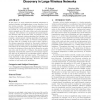Free Online Productivity Tools
i2Speak
i2Symbol
i2OCR
iTex2Img
iWeb2Print
iWeb2Shot
i2Type
iPdf2Split
iPdf2Merge
i2Bopomofo
i2Arabic
i2Style
i2Image
i2PDF
iLatex2Rtf
Sci2ools
SIGMETRICS
2010
ACM
2010
ACM
Coloring spatial point processes with applications to peer discovery in large wireless networks
In this paper, we study distributed channel assignment in wireless networks with applications to peer discovery in ad hoc wireless networks. We model channel assignment as a coloring problem for spatial point processes in which n nodes are located in a unit cube uniformly at random and each node is assigned one of K colors, where each color represents a channel. The objective is to maximize the spatial separation between nodes of the same color. In general, it is hard to derive the optimal coloring algorithm and therefore, we consider a natural greedy coloring algorithm, first proposed in [5]. We prove two key results: (i) with just a small number of colors when K is roughly of the order of log n/ log log n, the distance separation achieved by the greedy coloring algorithm asymptotically matches the optimal distance separation that can be achieved by an algorithm which is allowed to select the locations of the nodes but is allowed to use only one color, and (ii) when K = Ω(log n), ...
| Added | 18 Jul 2010 |
| Updated | 18 Jul 2010 |
| Type | Conference |
| Year | 2010 |
| Where | SIGMETRICS |
| Authors | Jian Ni, R. Srikant, Xinzhou Wu |
Comments (0)

